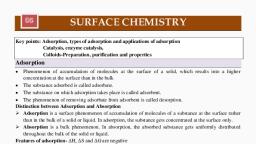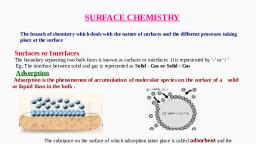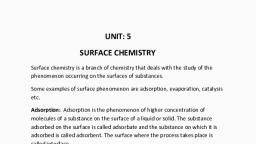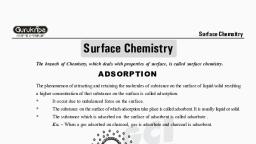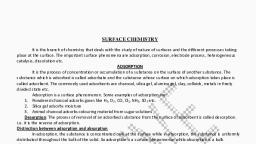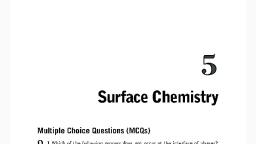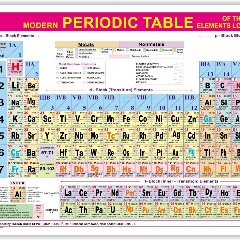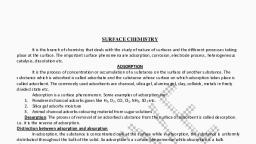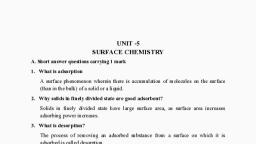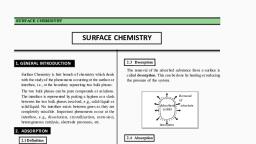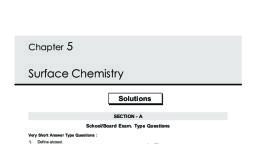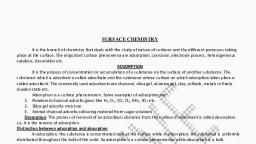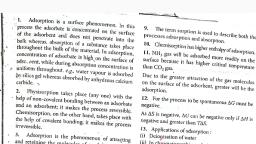Page 1 :
5.1. ADSORPTION, , The process in which a layer of liquid or gas stays on the, surface of a solid is called adsorption. e.g. painting of a wooden, or metallic article,, , 5.1.1 Types of Adsorption, (1) Positive adsorption (ii) Negative adsorption, Positive adsorption : When concentration of adsorbate is higher, on the surface than in the bulk or interior of the solid is called, positive adsorption. :, Negative adsorption : When concentration of adsorbate is, higher in the interior than on the surface it is called negative, adsorption., Adsorbate : A substance which is adsorbed. ., Adsorbent ; A substance on the surface of which adsorbate is, adsorbed,, Absorption : The process in which adsorbate is thoroughly, distributed in the adsorbent is called absorption., Adsorption, , Chemisorption, or or, Physical adsorption Chemical adsorption, Physisorption : The phenomenon in which adsorbate and, adsorbent are held by van der Waal's forces is called, physisorption, e.g. setting of layer of dust particles on a furniture., Chemisorption : The phenomenon in which adsorbate and, , Physisorption, , , , adsorbent are held by chemical bonds is called chemisorption”, , e.g. painting on a furniture,, , 5.1.2. Characteristics of Physisorption, , (a) It is non-specific /c. adsorbent has no specific preference, for adsorbate:, , (b) Nature of adsorbate, the nature of adsorbate. More liquefiable gases are readily, adsorbed. e.g. activated charcoal adsorbs different gases, , CO, > Ha., , , , , , Amount of adsorption depends on, , in the order, SO, >, , os, , he 5.1 : Difference between physisorption and, chemisorption, , , , Chemisorption, , , , Physisorption, , , , Takes place at low| Takes place at moderate, temperature., , It is multilayered., , Enthalpy ofadsorption is very, low. 20 - 40 kJ/mol., , Increase in pressure increases, , the rate of adsorption., , %, m, , temperature., , It is unilayered., , Enthalpy of adsorption i:, , high. 80-240 kJ/mol, , There is no effect of pressure, ’, , x, m, , Atconst. T, , , , Atconst. T P—— >, ps <-> Amount adsorbed, , Adsorption isotherm, Increase in temperature, increases kinetic energy of, adsorbate, hence, rate of, adsorption decreases., , P—> Pressure, Increase in temperature, , increases rate of adsorption, initially and then, rate ot, adsorption starts decreasing, due to breaking of bonds., , ’, m, x, ™m, , T—>, Adsorption tsobar, , , , , , —., , , , (c) Rate of adsorption increases with increasing critics, temperature,, , (d) Reversible nature : Physisorption of a gas by a solid i, reversible, , (c) Amount of adsorption increases when pressure is increase, It happens so because when pressure is increased, dase, tend to decrease the pressure by decreasing yvolum, (Le Chatelier’s principle). On the contrary, rate of adsorptio, , , , , , decreases with decreasing pressure., , , , Scanned with CamScanner
Page 4 :
Fr, , ace Chemistry, gull, , jecules of high molecular mass which catalyse reactions that, wan the cells. Enzymes are termed as biochemical catalysts., Inversion of cane sugar., , Invertase, , HO} hag? Hy OS Cg 204 + CoH, 206, , Glucose, , , , wl, , a), , Cy, , . Fructose, C4204) > 23 HOH +2CO,, , a Conversion of starch to glucose, (Col yoO0n + nH,0 “9 nC,H)20,, , (i) Maltose to glucose, , CH» Onan + 1,0" 2 C,H ,.04(aq), ) Conversion of milk into curd is catalysed by lacto, bacilli., , iy) In stomach protein is converted to peptide in presence, of enzyme pepsin., , (v1) In intestine pancreatic enzyme trypsin catalyses, conversion of protein into amino acid., , (iy, , 525 Characteristics of Enzymes, , \i) Efficiency : Enzymes are highly efficient catalysts. One, molecule of enzyme may transform one million molecules, of reactant per minute, Enzymes can enhance the rate of, reaction upto 107° times., , (ii) Specificity : Enzymes are highly specific. One enzyme can, catalyse only one reaction., , (ii) Optimum conditions = Activity of catalyst becomes, mayimum at optimum conditions of temperature (298 to, \10 K) and pH (5 to 8)., , (iv) Activators : A substance which increases catalyst activity, , of an enzyme is called activator., , Metal ions like Na’, Cu2*, Mn?*, etc. when weakly bonded, , lo enzyme increase their activity., , Co-enzymes : Small non-protein molecules bonded to the, , enzyme are called co-enzymes. They also enhance activity, , ofa catalyst., , Inhibitors or poisons :A substance which reduces or, , completely destroys the catalytic activity of an enzyme is, , called inhibitor or poison., , ae Mechanism of enzyme catalysis, och and key principle : According to this theory, enzymes, have a number of cavities of characteristic shape present, on their surface. The molecules of the reactant which have, shape such that, they can fit into these cavities just like, ty faa fits into a lock get adsorbed on the surface of catalyst., uced fit model (hand in gloves model) : According to, ‘his model when a reactant molecule approaches an enzyme, Satalyst the cavity on the surface of catalyst adjusts itself, ‘the size of reactant and catalyse the reaction., , WS), , 7 ;, The catalyst remains unchanged in mass and chemical, . Composition at the end of the reaction., Catalyst is effective even in small amount., , , , , , Ww, , iy, , , , , , 189, , @ Zeolites are good shape selective catalysts., @ Reactions that occur in the body of animals and plants, are catalysed by enzymes., , 5.3 COLLOIDAL STATE, , The state of a substance in which solute and solvent float with, each other is called colloidal state., , Solute is called dispersed phase and solvent dispersion, medium., , , , , , , , , , , , , , , , , , , , , , , , , , , , , , , , , , 5.3.1 Classification of Colloids, , e On the basis of physical states, , Dispersed] Dispersion] Name Example, , phase medium, , Solid Solid Solid sol | Alloys, coloured glass, Solid Liquid Sol Sulphur sol, gold sol., Solid Gas Aerosol | Smoke, , Liquid Solid Gel Jelly, , Liquid Liquid Emulsion | Milk, paints, , Liquid Gas Aerosol Humidity in air, , Gas Solid Solid foam| Cork, charcoal, , Gas Liquid Foam Soft drink, e On the basis of properties :, , Lyophilic Lyophobic, , Lyophilic : A colloidal solution in which dispersed phase and, dispersion medium attract each other., , Lyophobic : A colloidal solution in which dispersed phase and, dispersion medium repel each other., , Difference between lyophilic and lyophobic colloids., , , , Lyophilic Lyophobic, , , , It is prepared by special, methods., , 1.] It is prepared by simple, mixing of the dispersed, phase in dispersion, medium., , No stabilising agent is, needed., , It is reversible., , Surface tension decreases., 5 | Viscosity increases., e.g., Gum, gelatin, starch, albumin, other proteins in, water,, , i), , Stabilising agent is added., , we, , It is irreversible., Surface tension remains same., , >, , Viscosity remains same., e.g., Colloidal solution of, gold, Ag, Fe(OH),, As,S,., , , , , , , , , , 5.3.2 Methods of Preparation, e Dispersion method, , e Condensation method, , e Chemical method, , Scanned with CamScanner
Page 5 :
190, , i i ethoit, Dispersion met ; saatohtiesn, mM echanical dispersion :\ mixture of dispersed ph ;, oe de sollotdal mill The dises, c cdi ts fed nto a ee f, dispersion med ; : :, Hthe mllare rotating i apposite direction, the (wo phase, ofthe a ating, imin together and form colloidal solution, (>) Bredig's electrical dispersion ;, , A metal nv, , y, , , , —— lee, , , , Two rods of required metal are dipped into water, kept ina, Vessel placed in tee bath, Electric discharge, Saporises and vapours condense in cold w, agent ts added, Condensation method, (a) Peptization : The proc, colloidal state in pres, Peptization,, (b) Exchange of solvent, , Is carried out, metal, ater. Some stabilising, , ess of conversion of precipitate into, ence of some electrolyte is called, , (c) Excessive cooling., Chemical methods, , (a) Oxidation ; Preparation of colloidal sol of non-mets, , 2H,S + $0, > 38 + 2H,0, , (sal, , , , (b) Reduction : Metal sols, , are prepared by this method, 2AuCl,, , + 3HCHO + 3H,O 2Au + 3HCOOH + 6HC!, - {sol, , (c) Hydrolysis : Preparation of hydroxide sol,, FeCl, 4 3H,0 3 Fe(OH), + 3HCI, (sol), (d) Double decomposition ; Preparation of colloids from, Morganic salt, , AS:0, + 3H)S 5 As,S, + 3,0, (sol, , 5.3.3 Purification of Colloids, , (a) Ultrafiltration : Ordin, through which colloidal, teduced such that it, not the colloid, of filt, , ary filter paper has |, Particles can pass, Its Pp, allows only er, , arge pores, ore, ‘ystalloid (electroly, This. ts called ultr, ation of colloid from crystalloi, 's called ultrafiltration,, , (b) Dialysi : Purific, , size is, te) through, afilter paper. The Process, , d through ultrafilter Paper, , , , ation of colloid by the, 'sealled dialysis, In this method colloidal, a bag of parchment Pp:, 'S suspended into w, the membrane, , Process of diffusion, Solution is taken in, Membrane and the bag, , Huse into water through, comes pure, , alysis in presence of, , dialysis. In this Process,, applied by dipping wo electrodes in the, , per or cellophane, ater, Crystalloids dif, and colloid b, (c) Electro-dialysis pj applied electric, field is called eleciro. electric field is, , ainer. Electrodes, , * cont, , , , Mitac Excel in Chemis),, my), attract tons ol opposite charpe, , and Speed Up the, purification,, , Process 4, , 5.3.4 Properties of Colloids, (1) Colligative properties Colliy, , ative prop, solution are smaller th, , AN ITE solution be, particles is less due to Nigh molecular mas, mole fraction, , EMH OF colloid,, “AUS Hut bey of, , Sand therefore hin, (hb) Kinetic properties : Colloid, , Hindom and rapid motion This motion is cal], movement, This movement arise, bombardment. of, , al sol particles are alway, , ed brownian, 5 due to UNbalan,, , molecules of dispersion Medium on 4, , molecules of dispersed phase, (c) Optical Property + When tigi, , ht falls on colloid, absorbs the light, , and scatters it, this seat, Tyndall effect. The path of lig, is called Tyndall cone., , Conditions for Tyndall effect :, , particles should not be much smaller, light., , $01, 5), tering of light js Calley, ht passing through the, , , , Collong, , Diameter of Colloidal s,\, han wave length of incid, , Difference in refractive indices of dispersed phase, medium should be large., Colour : The colour of colloidal sol depends on the size of, colloidal particles. Particles Of same size scatter light of same, wavelength and have same colour,, (d) Electrical Property : Migra, towards electrode of Opposite, (cataphoresis)., Electro-osmosis : The mi, 4 semipermeable memb:, direction of motion of s, electro-osmosis., , (e) Coagulation or flocculation ;, sol particle is called Coagulation,, Methods of coagulation :, , and disper, , , , tion of colloidal sot particles, charge is called electrophoresis, , gration of dispersion medium through, rane in the direction Opposite to the, , ol under applied electric field is called, , Precipitation of colloidal, , ° By adding electrolyte : When excess of an electrolyte is, added toa colloidal sol, sol particles attract ions of ‘opposite, charge, get neutralised, come together and thus settle down, , ., , By mixing colloids of opposite charge : Colloidal sol, Particles of opposite charge when mixed together, combine, , with each other and get neutralised which causes, coagulation,, , * By boiling : When colloidal sol is boiled, its kinetic energy, , . se . ‘i i isions, , increases, rate of collisions increases, during collisi vif, ., al, , adsorbed ions may get disturbed, they loose charge, , , , coagulate, aw, © By dialysis ; Prolonged dialysis of a colloidal _ ie, . eu coagulation, remove electrolytes completely and lead to coagu, ., , . s 2 lied, Coagulation by electrophoresis : Under the ee, electric field colloidal sol particles move towards elec, , ‘i charged and, Of opposite charge. At the electrode, it gets dischary, coagulated, , Scanned with CamScanner


